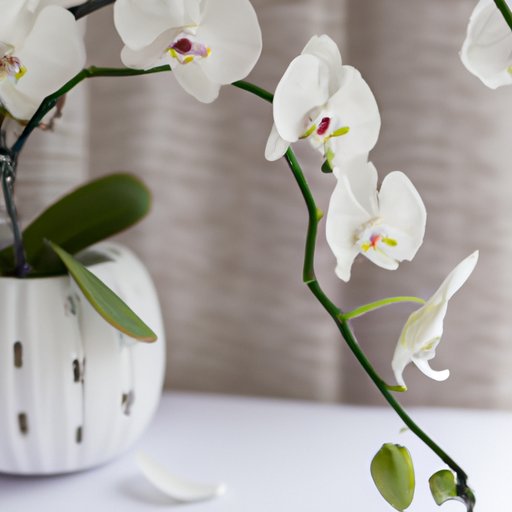Introduction
Orchids are fascinating and beautiful plants that come in a wide variety of shapes, sizes, and colors. Whether you’re a seasoned gardener or just starting out with your green thumb, orchids can be a rewarding and delightful addition to your plant collection. In this article, we will explore the best practices for caring for orchids, including tips for beginners, do’s and don’ts of orchid care, expert advice, simple steps for maintenance, common problems and solutions, and secrets to creating the perfect orchid environment.
Top Tips for the Beginner Orchid Grower
Choosing the right orchid is the first step to success. Consider the lighting and temperature conditions in your home or garden, as well as the humidity levels and the type of orchid you prefer. Phalaenopsis orchids are a great choice for beginners, as they are easy to care for and adapt well to different environments. You can also choose from dendrobium, cattleya, and other popular types of orchids.
Providing proper light and temperature is crucial for orchid growth. Most orchids need bright, indirect sunlight, although some varieties may require more shade or filtered light. Temperature should be between 60 to 75 degrees Fahrenheit during the day and 55 to 65 degrees Fahrenheit at night.
Watering and feeding orchids is another important aspect of care. Orchids should be watered regularly but not overwatered or allowed to sit in standing water. Allow the soil to dry slightly between waterings. Fertilize your orchids with a balanced, water-soluble fertilizer once a month during the growing season.
Repotting orchids is necessary every one to two years as they outgrow their containers and the soil deteriorates. Choose a pot that provides proper drainage and allows air to circulate through the roots. Use a high-quality orchid mix that is well-draining and provides adequate nutrients.
Common mistakes to avoid include overwatering, exposing orchids to direct sunlight, using the wrong type of soil or fertilizer, and neglecting to repot as needed.
The Do’s and Don’ts of Orchid Care
Do maintain humidity levels between 50 to 60 percent by using a humidifier, pebble tray, or misting your orchids regularly. Provide proper ventilation by leaving space between plants and using fans to circulate air.
Do fertilize your orchids regularly with a balanced, water-soluble fertilizer during the growing season. Prune your orchids as needed to remove dead or damaged foliage.
Don’t overwater your orchids or allow them to sit in standing water. Avoid exposing them to direct sunlight, extreme temperatures, or drafts. Don’t neglect pests and diseases, as they can quickly damage or kill your orchids.
Expert Advice: How to Keep Your Orchids Thriving
Learning from experienced orchid growers is a great way to enhance your orchid care skills. Join orchid societies, attend workshops or seminars, and seek advice from local nurseries and garden centers. Common challenges for orchid growers include pests and diseases, inadequate lighting or temperature, and over or under-watering.
Regular inspection and maintenance is key to keeping your orchids healthy. Check for pests or signs of disease, monitor the soil moisture levels, and adjust lighting and temperature as needed. Be patient and don’t give up on your orchids if they are slow to bloom or show signs of stress. With proper care, they will thrive.
Simple Steps for Orchid Maintenance
Maintaining your orchids is relatively easy and straightforward. Water them on a regular schedule, ideally once a week but adjusting as necessary for your particular orchid’s needs. Fertilize them once a month during the growing season. Prune as needed to remove dead or damaged foliage.
Cleaning is also important to promote the health of your orchids. Remove any dead leaves or debris from the pot and leaves. Wipe the leaves with a damp cloth to remove dust or insects.
Finally, monitor for pests and diseases, and treat them promptly. Common pests include mealybugs, spider mites, and scale insects. Common diseases include root rot, bacterial blight, and fungal infections.
Troubleshooting Common Orchid Problems
Wilting, yellowing, and dropping leaves can be indicators of over or under-watering, inadequate lighting, or pests or diseases. Infestations and infections should be treated promptly to prevent spreading to healthy plants.
Identifying and treating common issues involves close observation, research, and plant knowledge. Consider consulting with a local orchid expert or garden center for assistance in identifying and treating issues.
Secrets to Creating the Perfect Orchid Environment
Factors contributing to orchid success include proper lighting, humidity, temperature, soil, and potting containers. Ensure that your orchids receive bright, indirect light, are protected from drafts or severe temperatures, and have proper drainage. Use an orchid mix that is well-draining and provides adequate nutrients, and choose a potting container that allows air to circulate through the roots.
Conclusion
In conclusion, orchid care can be easy and rewarding with the proper knowledge and practices. Remember to choose the right orchid, provide proper lighting and temperature, water and feed regularly, repot as needed, and avoid common mistakes. Do maintain humidity levels, provide proper ventilation, fertilize regularly, prune as needed, and don’t overwater or neglect pests and diseases. Seek advice from experienced orchid growers, maintain your orchids regularly, monitor for pests and diseases, and troubleshoot common issues as they arise. With these tips and techniques, your orchids will thrive and bring beauty and joy to your home or garden.
